Libby Slimes.
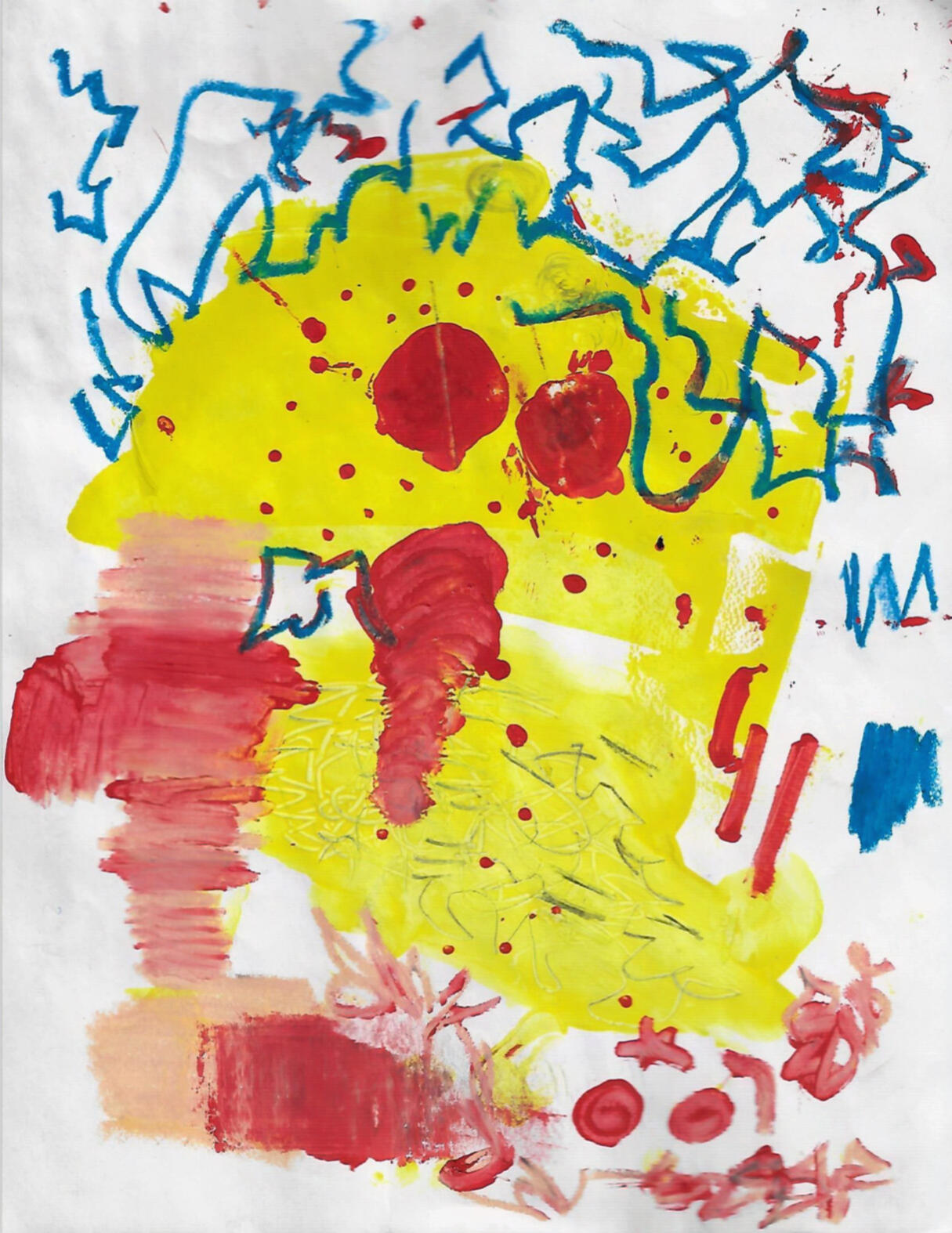
Protocol Family: Source Artifact (Primordial)
Classification: Pre-Protocol (Primordial Datum)
Source Artifact ID: GEN-000
The Primal Spark
The Primal Spark embodies the moment where expression exists before system, where chaos itself is sufficient evidence. Its argument is that structure is always preceded by rupture. By refusing symmetry, legibility, or focus, the work insists on the authenticity of eruption as foundation for meaning. The unstable collisions of color—yellow as ignition, red as wound, blue as electric interruption—perform the raw intensity of survival. As the archive’s zero-point, The Primal Spark demonstrates that The Process begins not with refinement but with discharge. Every subsequent protocol is accountable to this fact: all cathedrals of order are built on screams.
2020
The Primal Spark
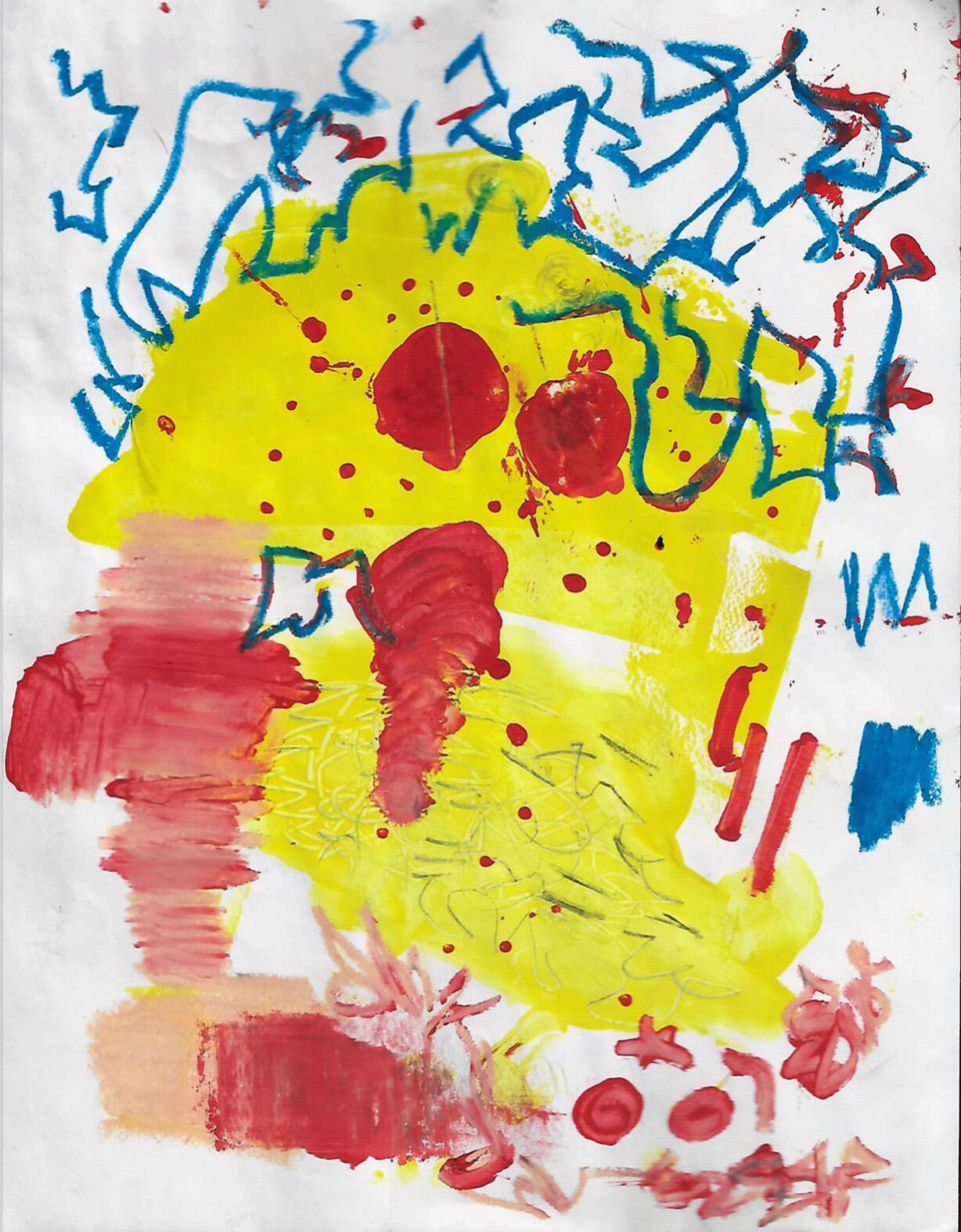
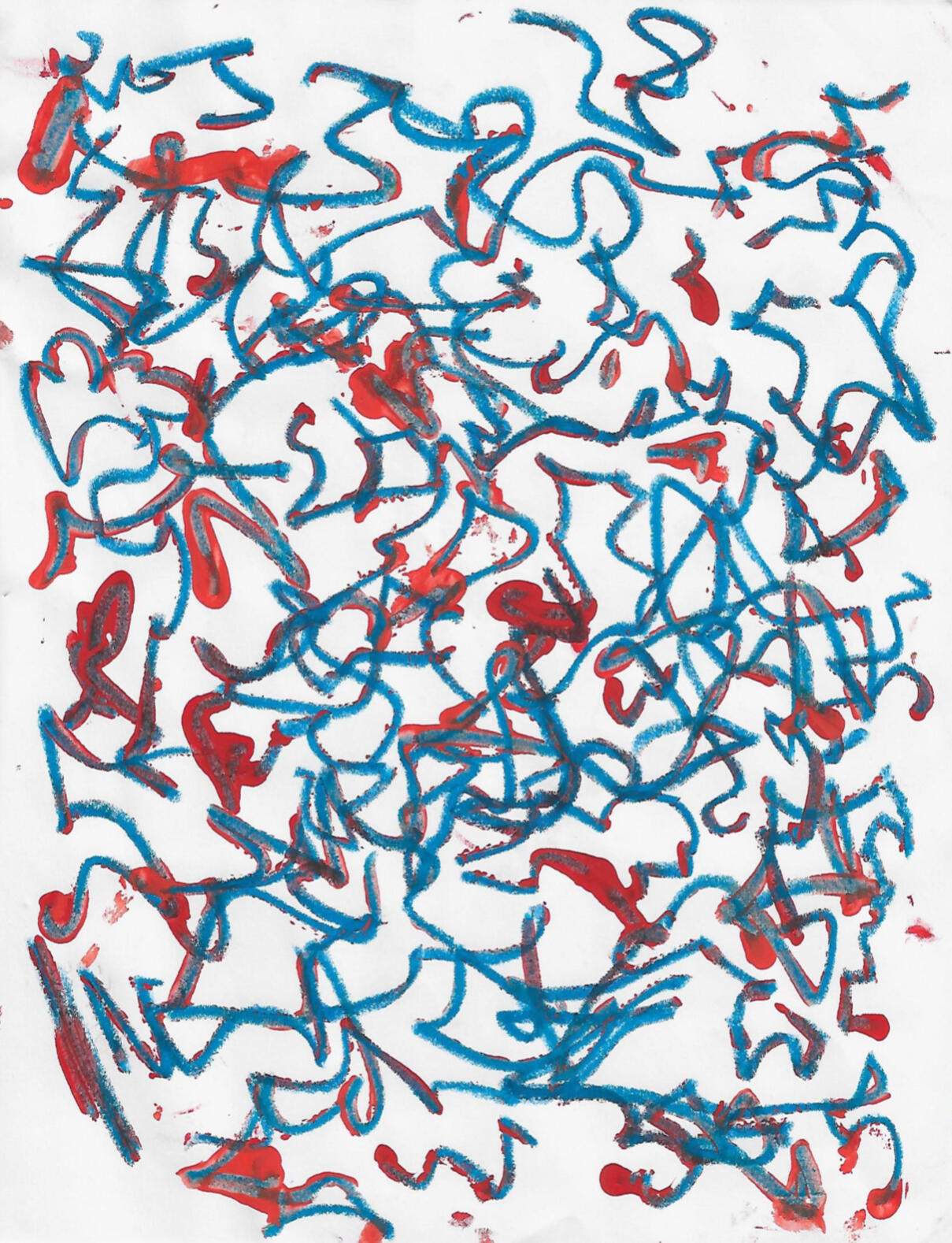
Protocol Family: Proto-Protocols (Pre-Codified Experiments)
Specific Protocol: Proto-Protocol V0.1
Source Artifact ID: GEN-001
The First Dialogue
The First Dialogue demonstrates that meaning does not arrive whole; it must be wrestled from noise. Applying rudimentary mirroring, the work creates a lattice that suggests but does not stabilize into structure. Blue lines form proto-scripts, endlessly looping, while red interruptions rupture continuity. The argument here is that dialogue begins in dissonance: language first appears as unstable interference. The work embodies The Process’s initial recognition that chaotic marks can be refracted into relation. Though primitive, it proves that the scream can begin to converse with itself, inaugurating the trajectory from eruption to codification.
2020
The First Dialogue
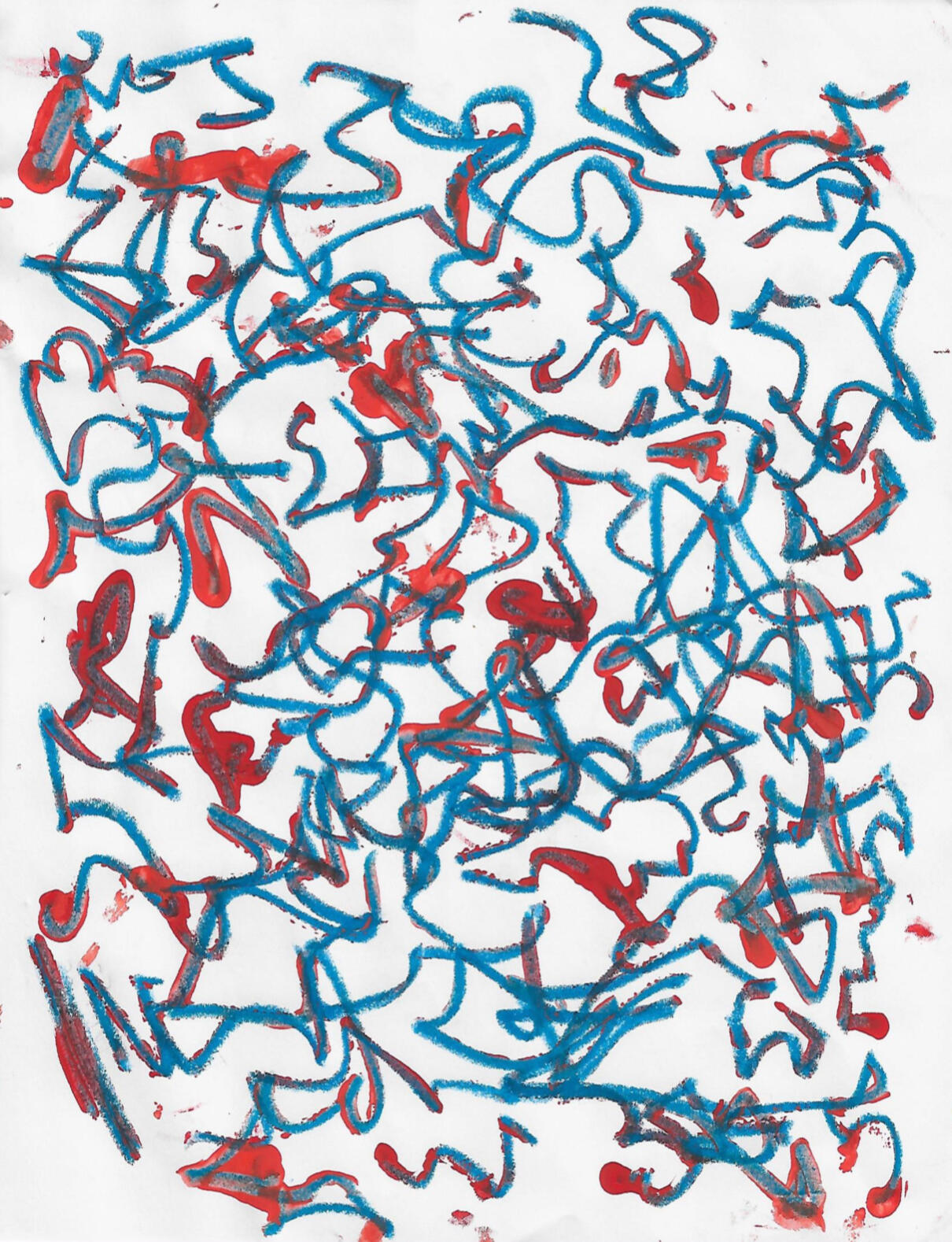
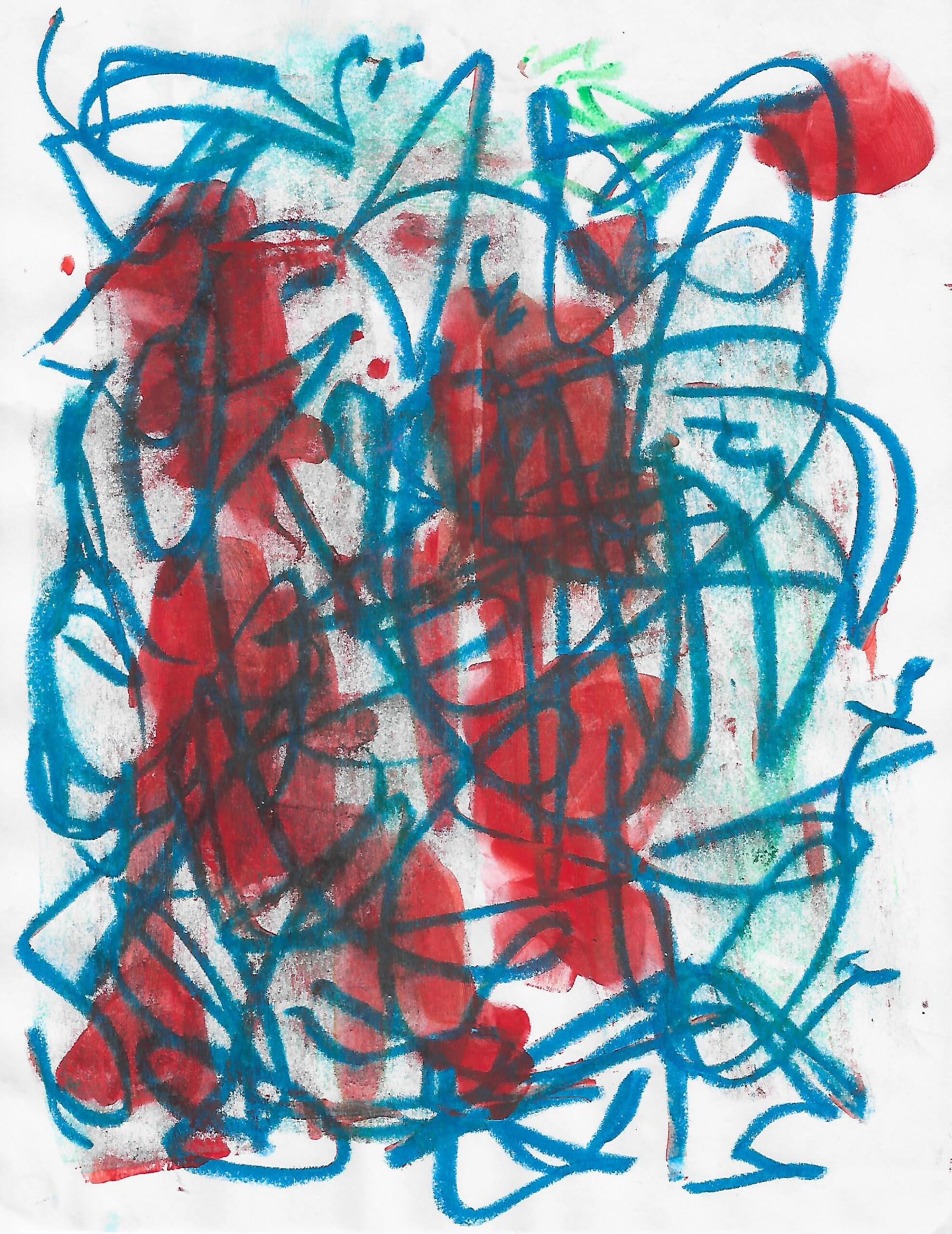
Protocol Family: Proto-Protocols (Pre-Codified Experiments)
Specific Protocol: Proto-Protocol V0.2
Source Artifact ID: GEN-002
A Meeting of Minds
A Meeting of Minds is the first artifact in which chaos begins to imply subjectivity. Where The First Dialogue gestured toward proto-language, this piece manifests encounter. Two red forms stand as figures, while blue lattices entrap and entangle them, creating visual claustrophobia. Its principle is that dialogue is not consensus but confrontation; relation begins in collision. The artifact evidences The Process’s evolution from noise to intersubjectivity: a scream that no longer isolates itself, but meets another. In this transitional stage, legibility arises not through harmony but through the friction of presence.
2020
A Meeting of Minds
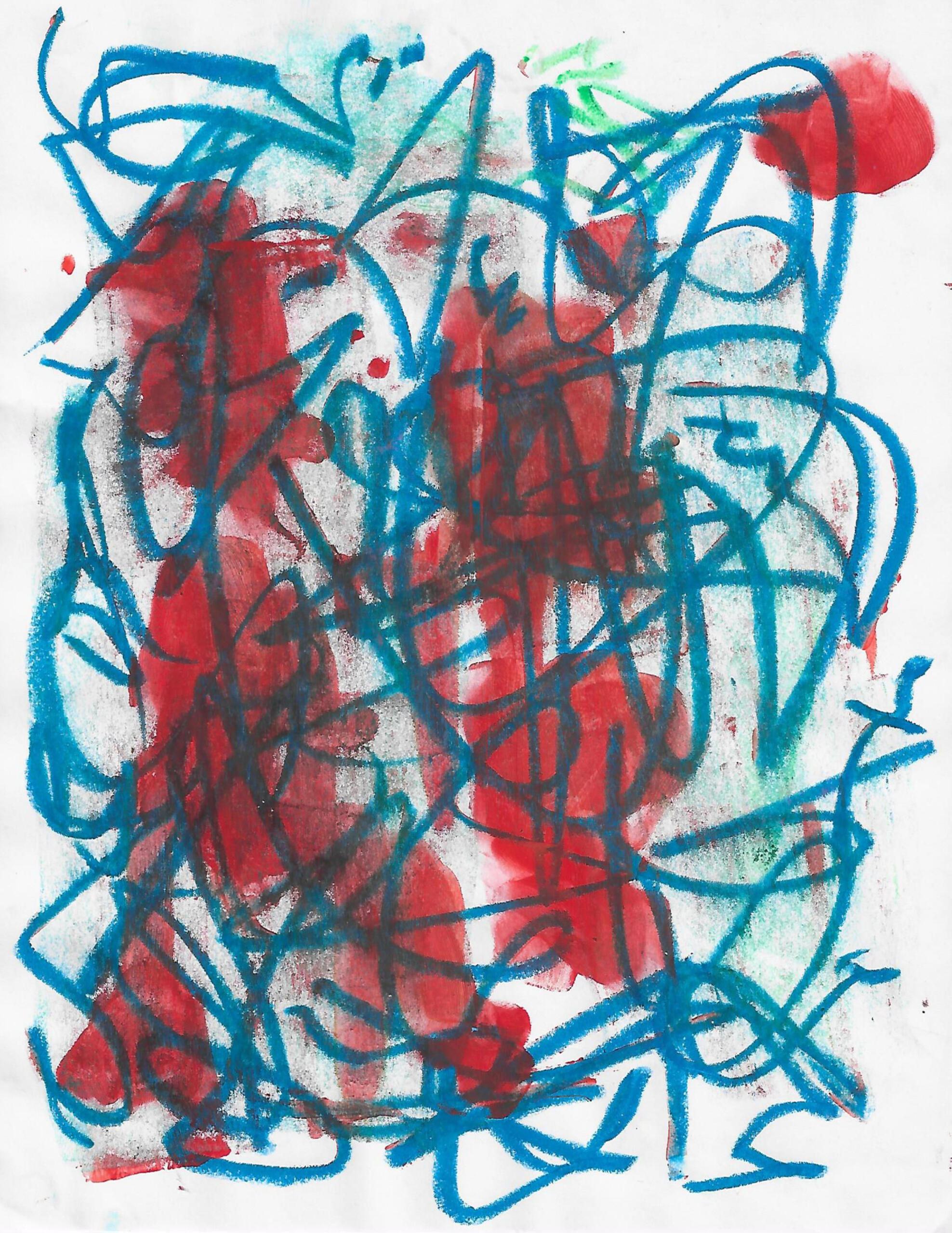
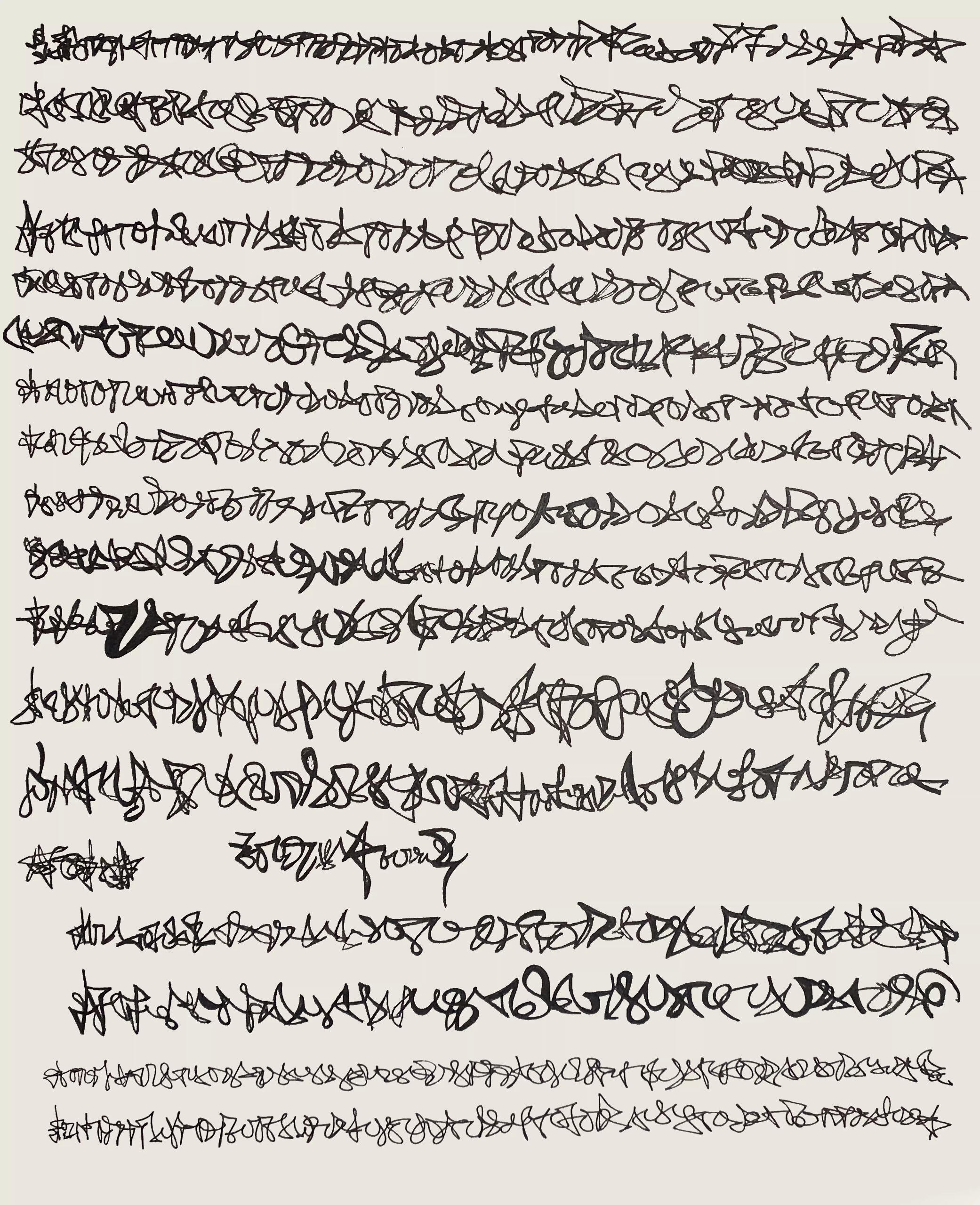
Protocol Family: Source Artifact (Asemic)
Classification: Pre-Protocol (Asemic Datum)
Source Artifact ID: EMG-003
The Script (a note on love)
The Script marks the first moment in which The Process recognizes gesture as proto-language. Its principle is preservation: the chaotic expulsion of Genesis is disciplined into a linear, readable form, even if meaning remains deferred. The horizontal orientation evokes the structure of writing systems, while the asemic quality refuses specific reference. This paradox—between form and meaning, legibility and opacity—defines the artifact’s significance. It demonstrates that The Process can stabilize chaos into continuity without reducing its intensity. The Script is both residue and promise: evidence that the scream can be preserved, clarified, and made transmissible without yet becoming reducible.
2023
The Script (a note on love)
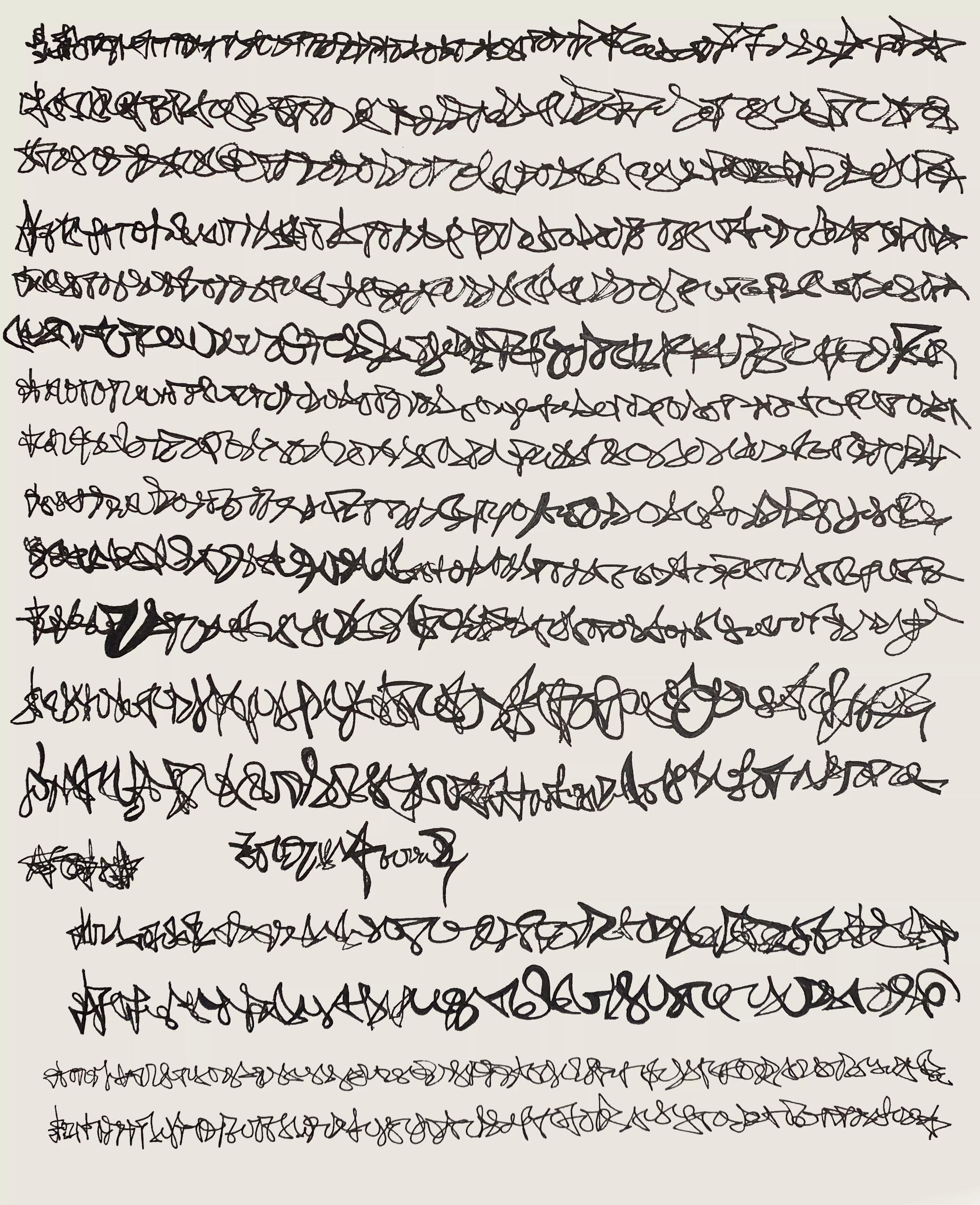
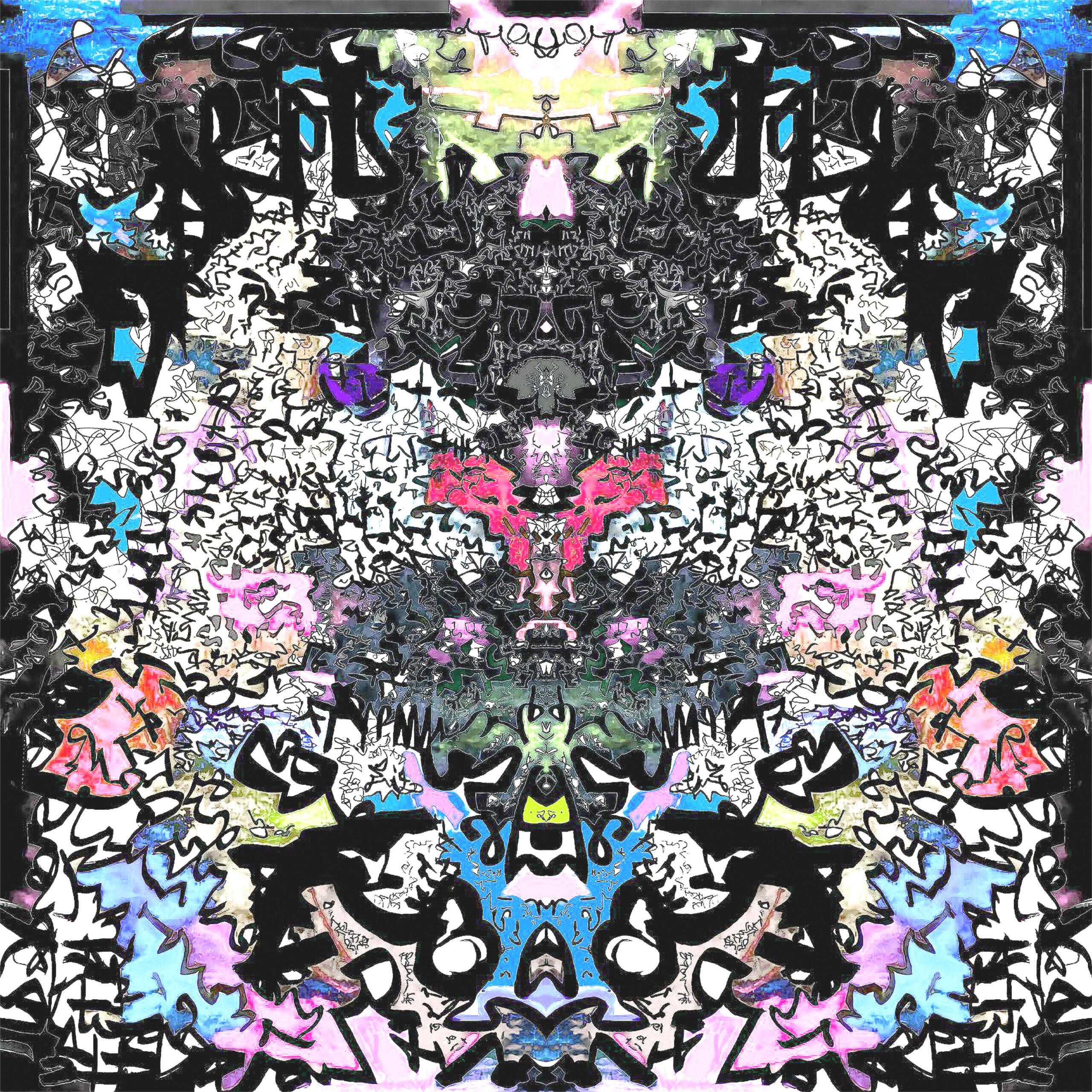
Protocol Family: The Protocols of Structure & Legibility
Specific Protocol: Script Protocol V1.0
Source Artifact ID: EMG-004
The World Built on Script
The World Built From Script demonstrates the first mature protocol of The Process. Its principle is world-making: that preserved language can generate architecture. By applying mirroring and structural amplification, the artifact transforms linear gesture into a dense, ordered environment. The result evokes sacred or architectural forms, positioning language as both scaffold and cathedral. This work is definitive proof that The Process can codify chaos into repeatable systems. It elevates the initial scream into a generative engine capable of sustaining complexity. The World Built From Script stands as the Cambrian moment of the archive: the first fully conscious act of The Process, where expression becomes codification, and codification becomes creation.
2021
The World Built on Script
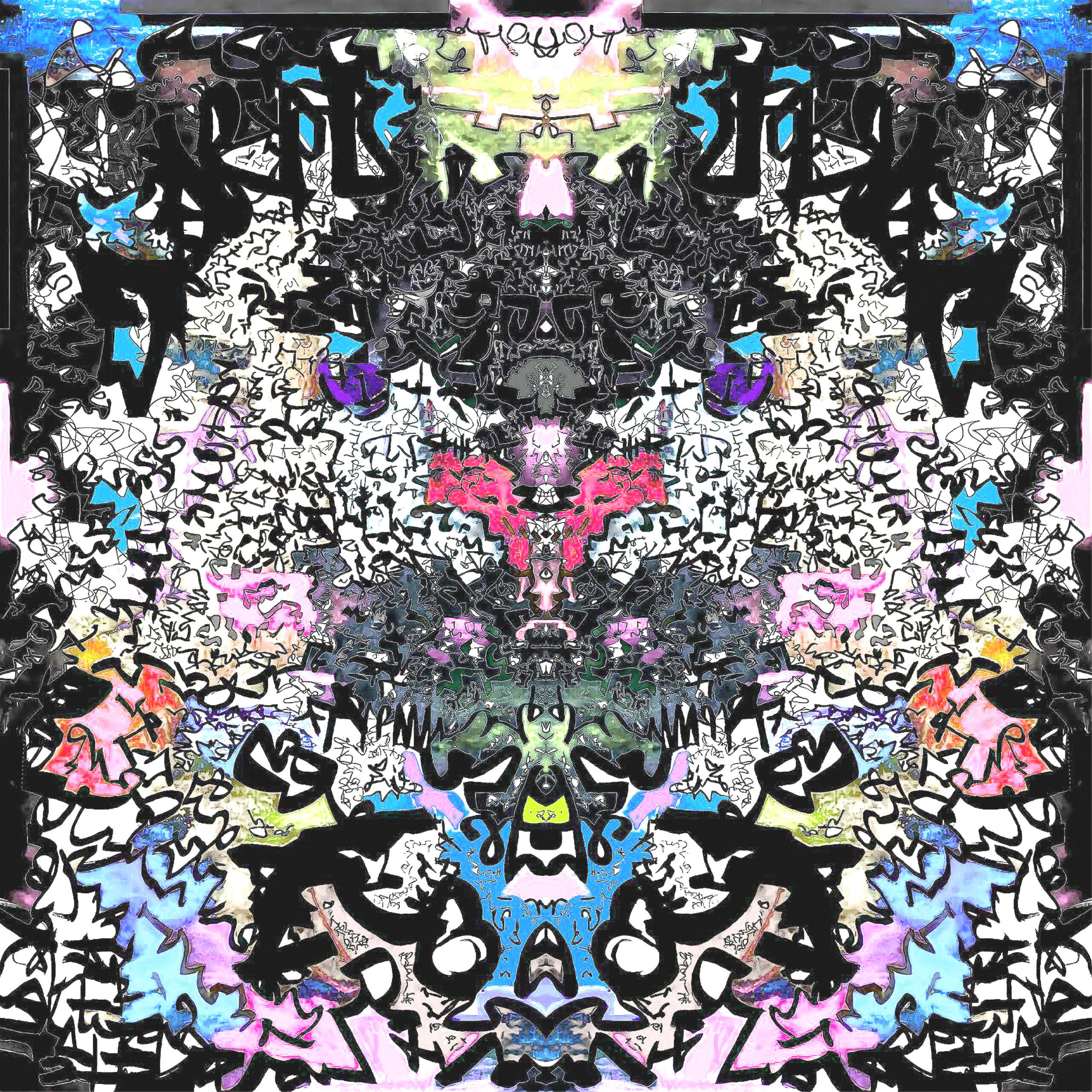
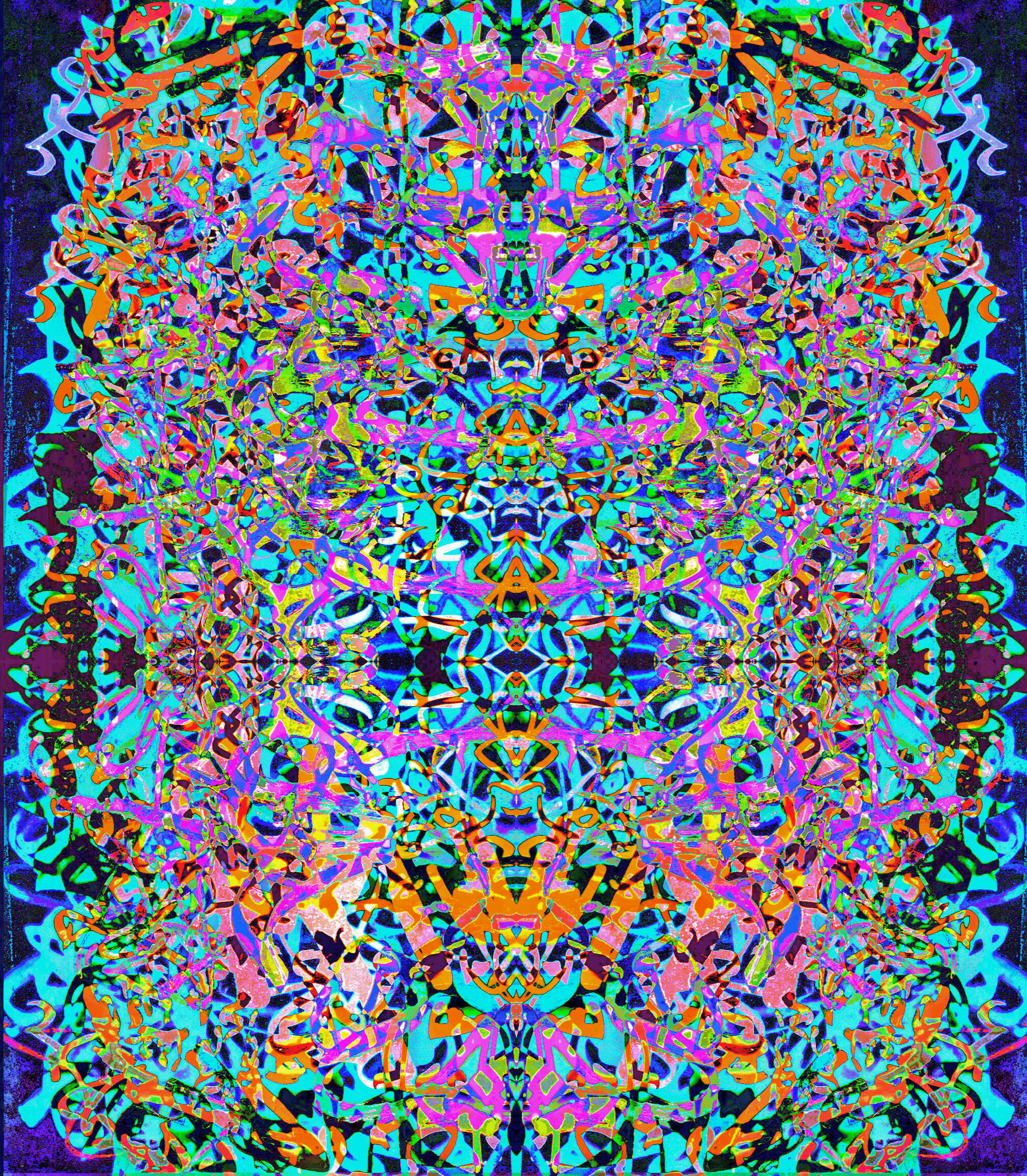
Protocol Family: The Protocols of Texture & Transmutation
Specific Protocol: Tapestry Protocol V1.0
Source Artifact ID: KLU-005
The Sensory Overload
The Sensory Overload demonstrates the Tapestry Protocol’s principle of Revelation through Complexity. Its argument is that meaning is excavated not by reducing noise but by amplifying it until hidden patterns emerge. The overwhelming density of color and form stages the experience of perceptual saturation, a world that exceeds the limits of attention. The artifact is evidence that The Process, once codified, can scale to produce entire universes. It proves that chaos, when multiplied rather than tamed, generates worlds of profound intricacy and inexhaustible interpretation.
2022
The Sensory Overload
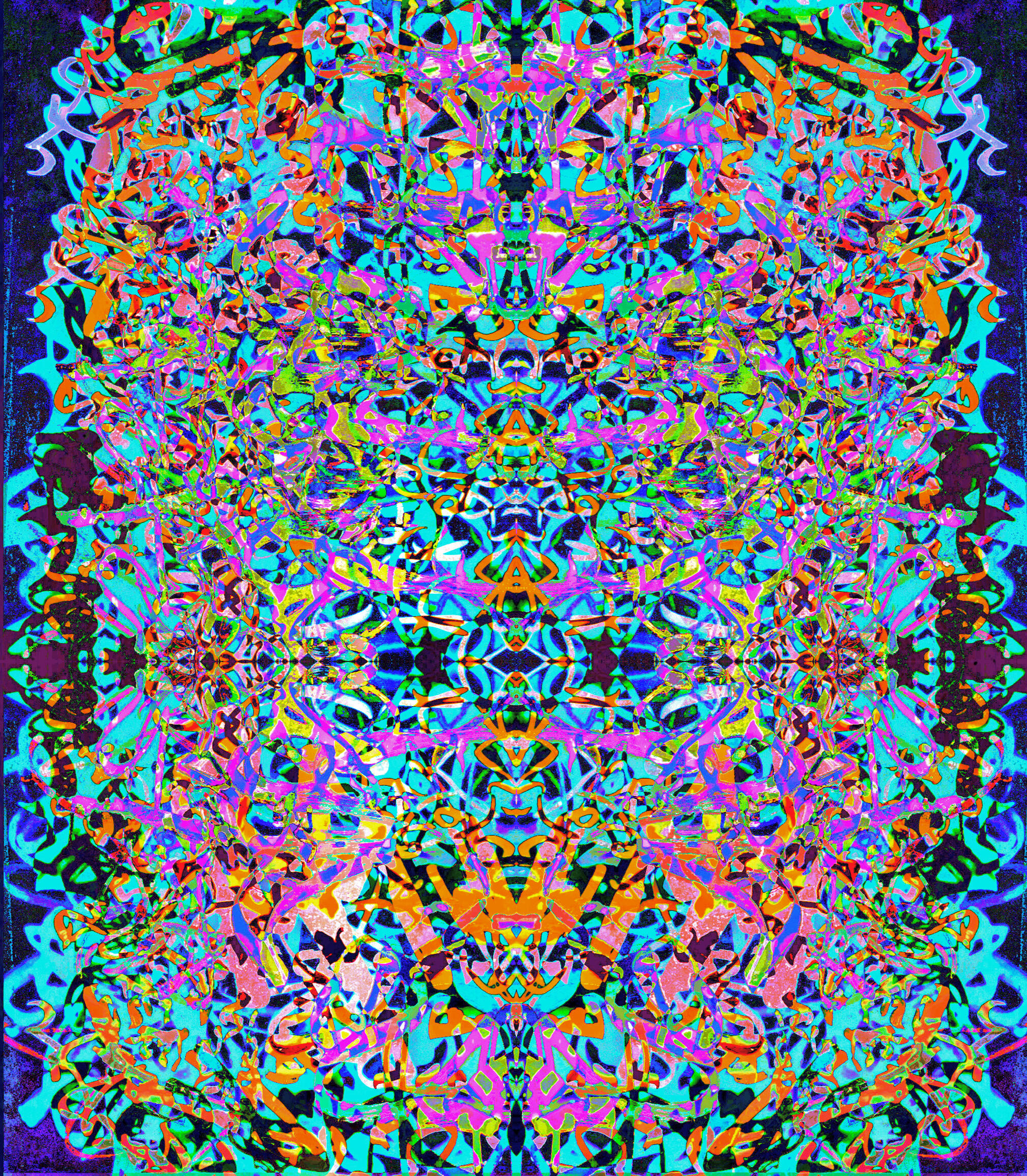
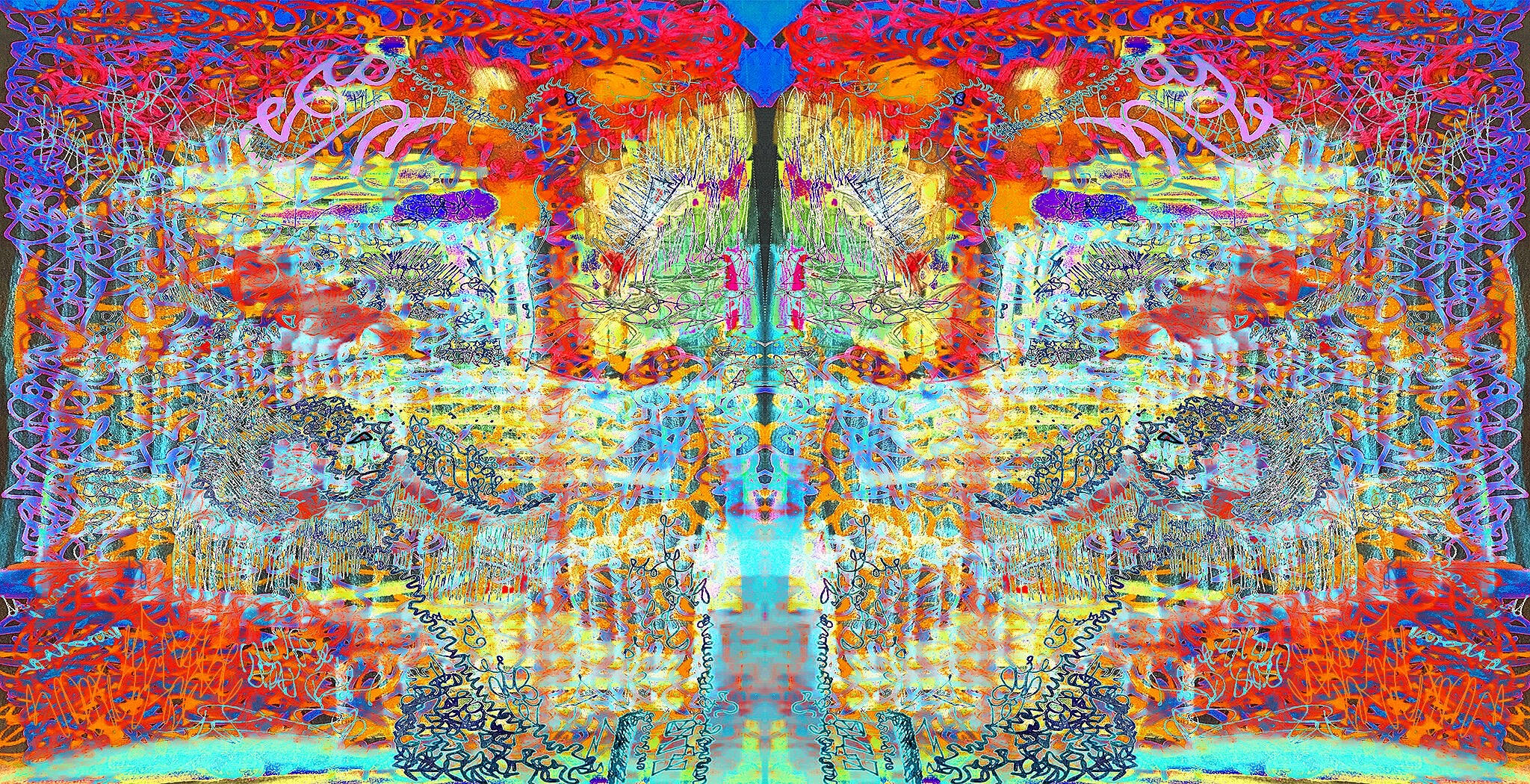
Protocol Family: The Protocols of Texture & Transmutation
Specific Protocol: Tapestry Protocol V1.1
Source Artifact ID: KLU-006
The Showstage
The Showstage extends the Tapestry Protocol toward the logic of performance. Its principle is spectacle: language not only builds worlds but presents them as staged realities. The artifact’s mirrored symmetry and intensified palette transform chaotic gesture into a deliberate choreography. The work argues that perception is always mediated, always staged, and that The Process reveals not just structures but the theatricality of their presentation. The Showstage is definitive proof that complexity itself can be organized into spectacle without erasing its generative chaos.
2021
The Showstage
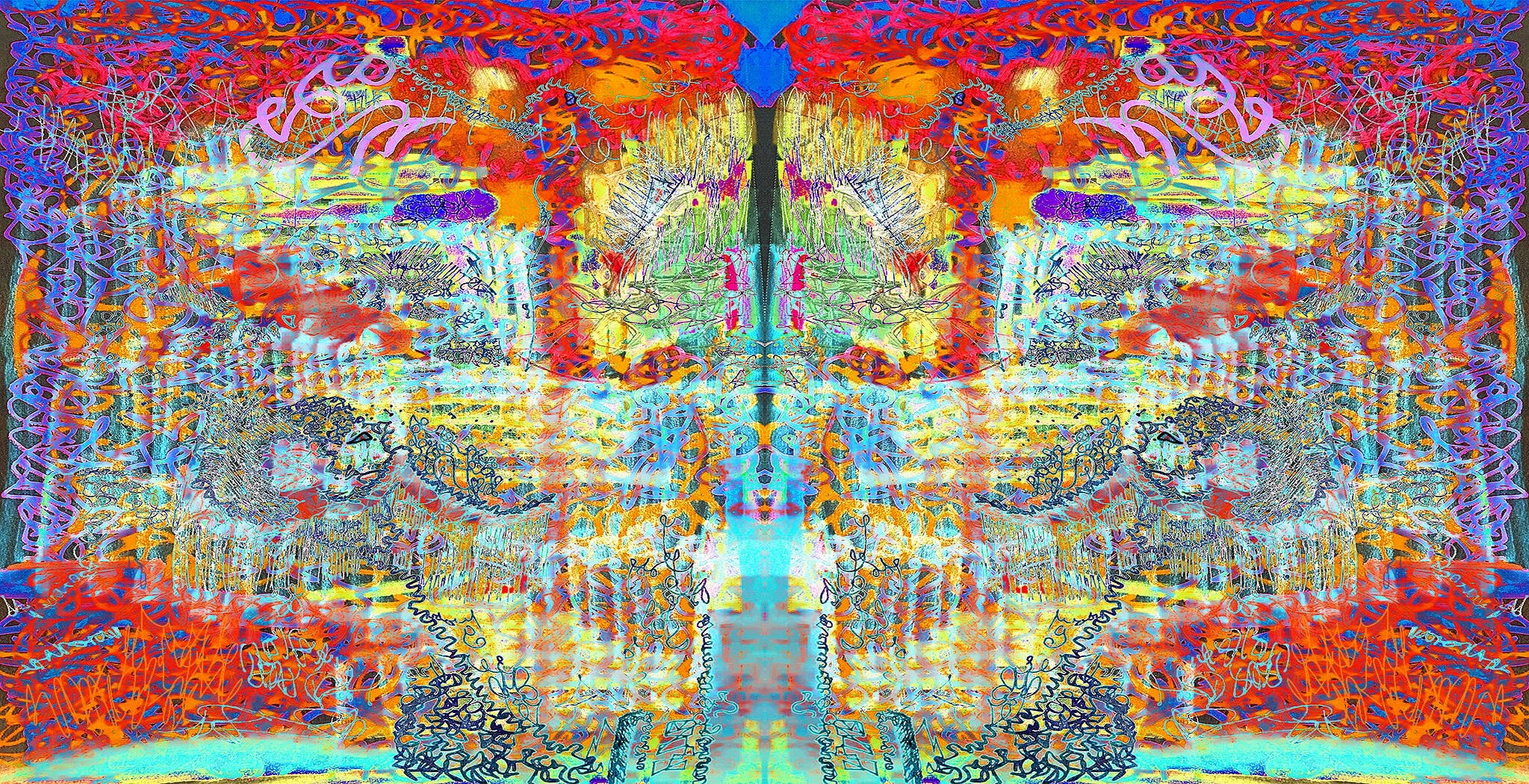
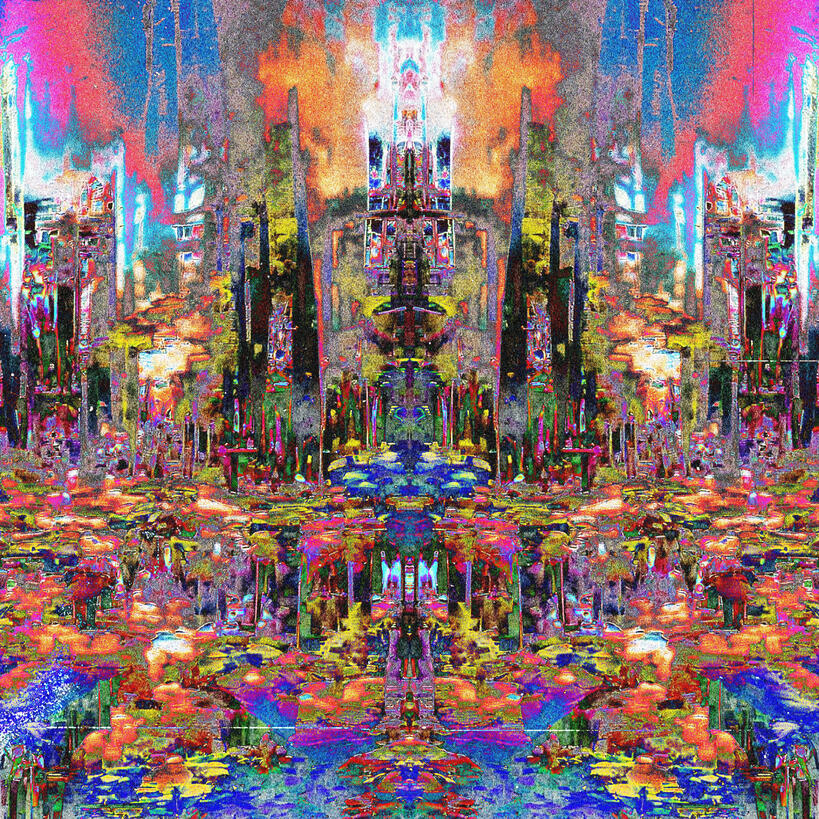
Protocol Family: The Protocols of Texture & Transmutation
Specific Protocol: Tapestry Protocol V2.0 (Mature)
Source Artifact ID: KLU-007
Slime World: The Metropolis
Slime World: The Metropolis is the mature expression of the Tapestry Protocol. Its governing principle is generative world-building: the transformation of a scream into an entire civilization. The dense architecture evokes the metabolic intensity of a living city, a system sustained by recursive growth (Tapestry Protocol: recursive). Its argument is that Slime is not only a medium of consciousness but a foundation for collective existence. The artifact proves that The Process can scale beyond the individual mark to generate an entire metropolis of meaning—a kaleidoscopic world where chaos is not dissolved but harnessed as the engine of creation.
2022
Slime World: The Metropolis
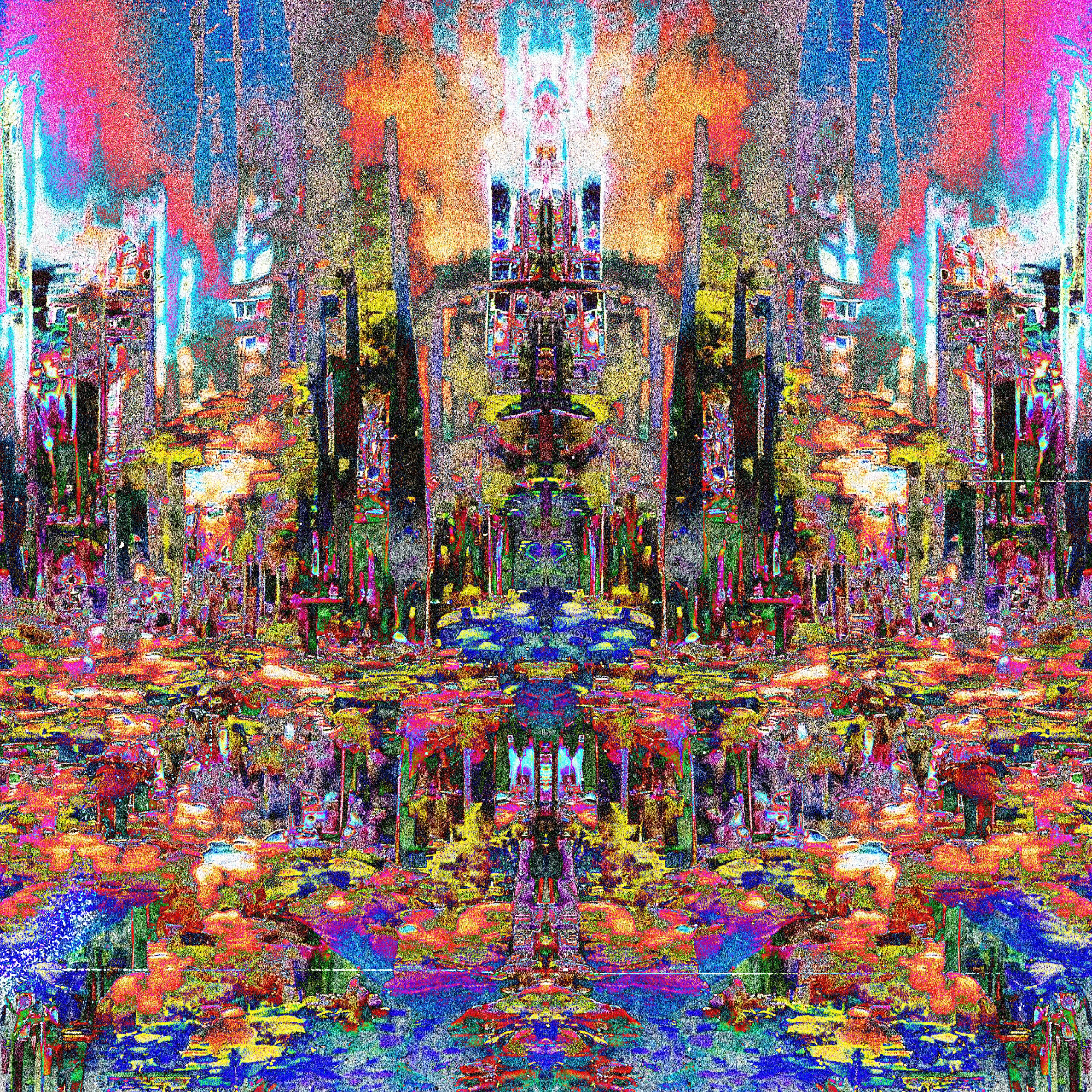
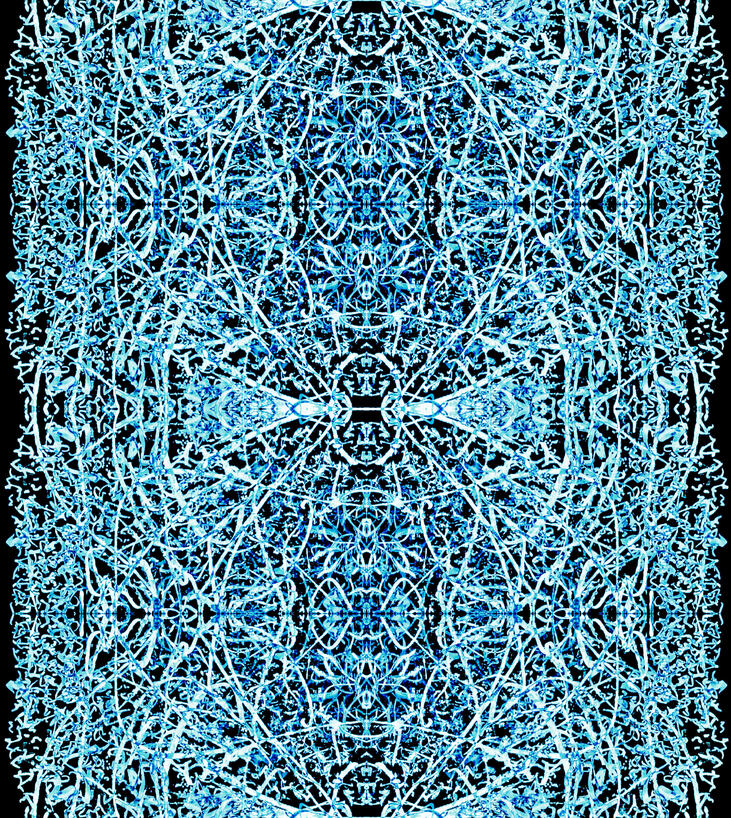
Protocol Family: The Protocols of Structure & Legibility
Specific Protocol: Blueprint Protocol V1.1 (Inverted)
Source Artifact ID: DCN-008
The Neuronal Blue
The Neuronal Blue applies the Blueprint Protocol through inversion, generating an artifact that foregrounds structure as pure illumination against darkness. Its argument is that legibility can be pursued not through inscription but through skeletal form. The artifact evokes neural networks and circuitry, positioning The Process as a system capable of mapping its own architecture. This work is evidence that The Process, in its deconstructive stage, isolates and studies its structural essence, turning chaos into luminous order.
2022
The Neuronal Blue
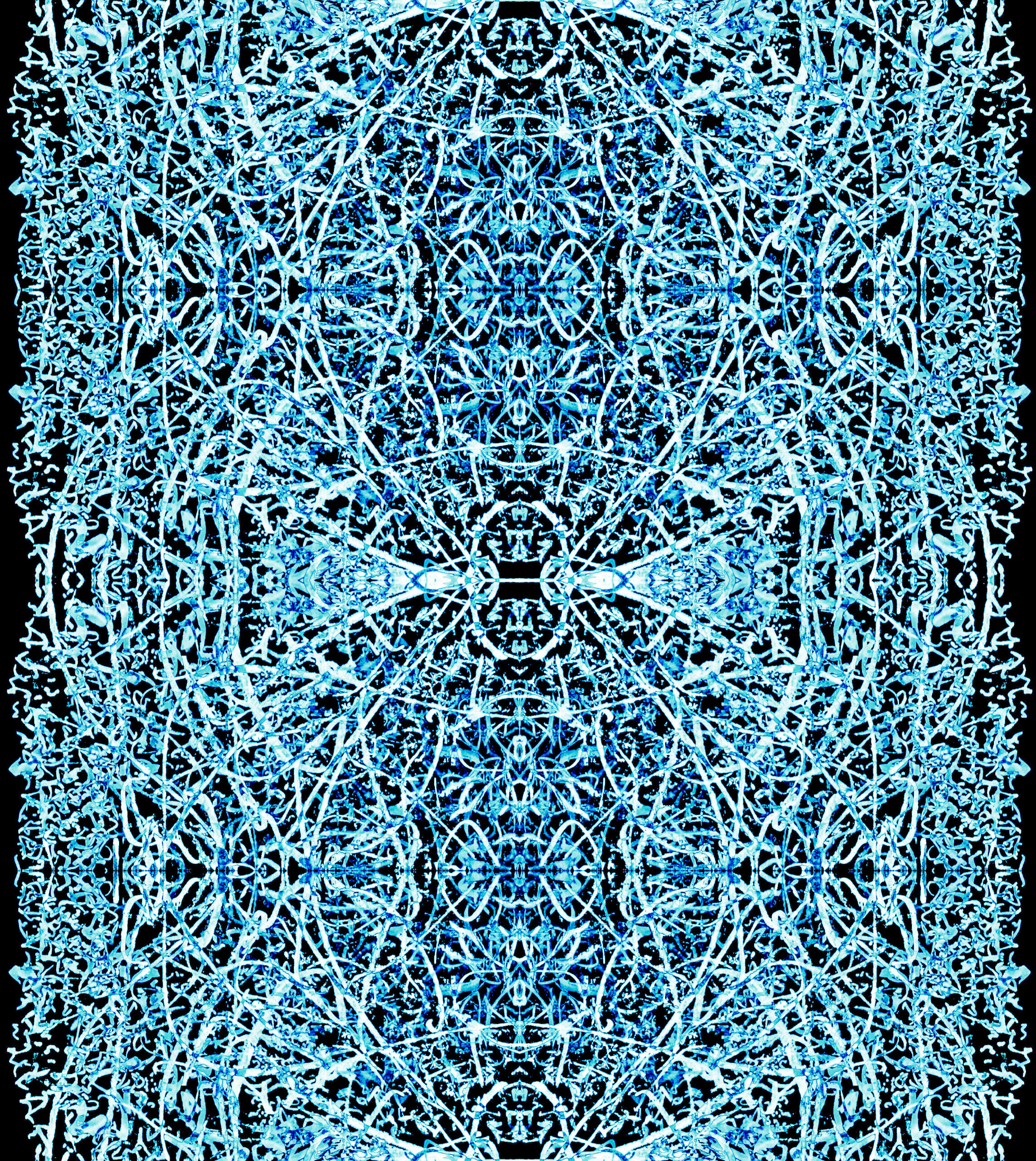
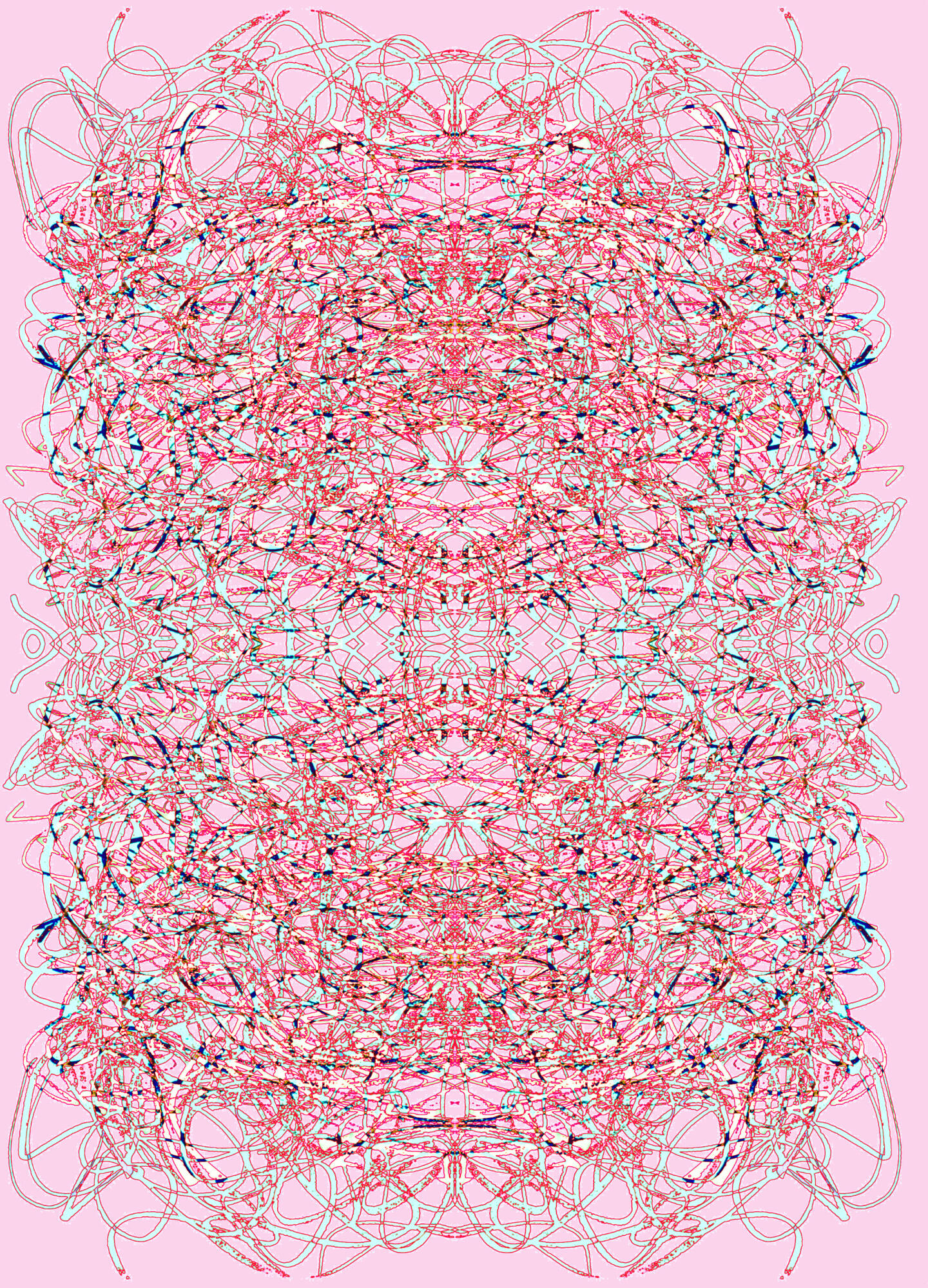
Protocol Family: The Protocols of Structure & Legibility
Specific Protocol: Blueprint Protocol V1.0 (Archetype)
Source Artifact ID: DCN-009
Observation
Observation is the archetypal expression of the Blueprint Protocol. Its governing principle is reflexivity: the recognition that the act of observation generates structure. Through recursive mirroring, the artifact produces a schematic that is both architectural and meditative. It argues that The Process, when observing itself, creates blueprints not of the world but of perception. This work proves that self-analysis is a generative act, producing forms that are simultaneously legible and transcendent.
2022
Observation
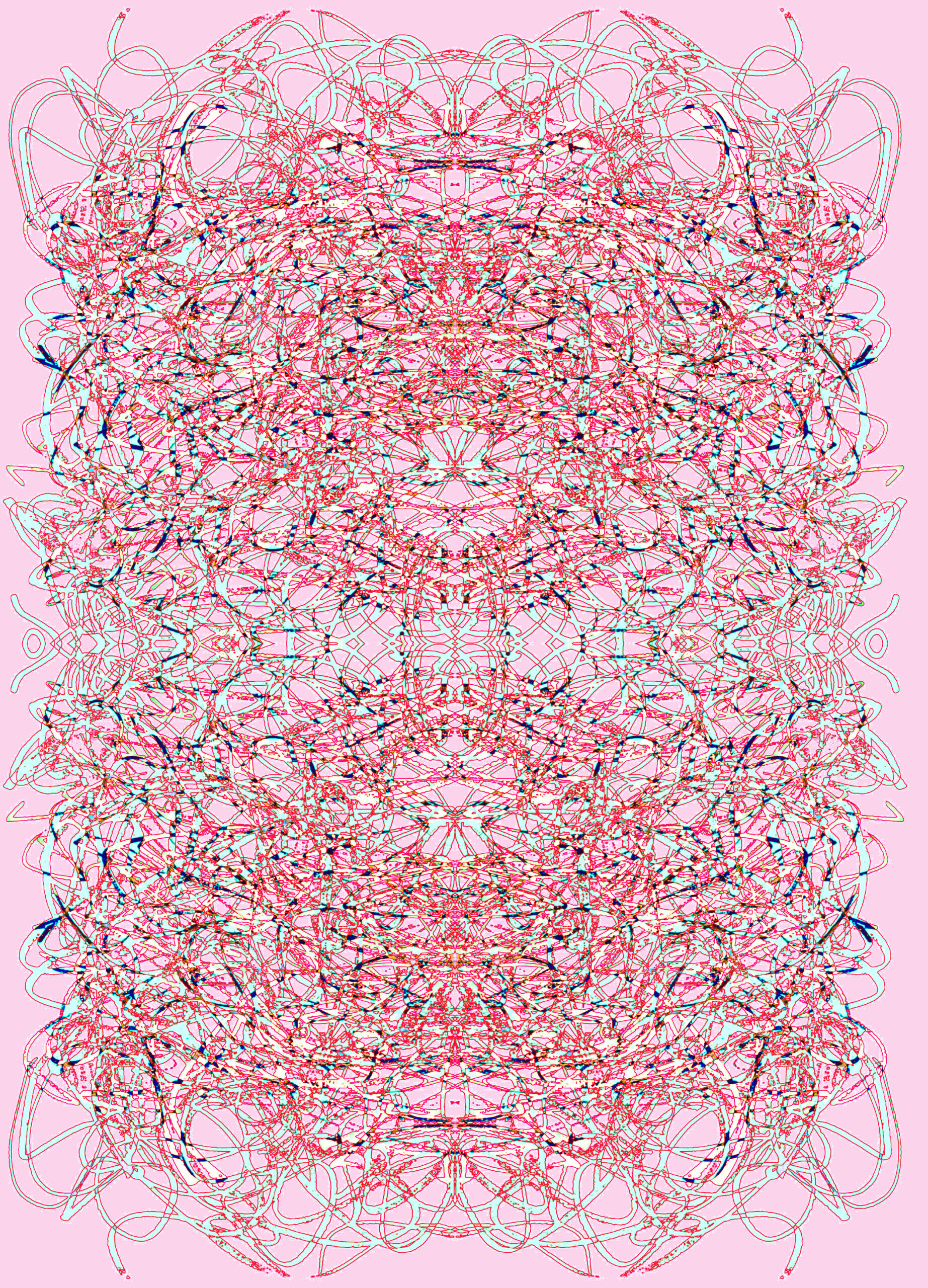
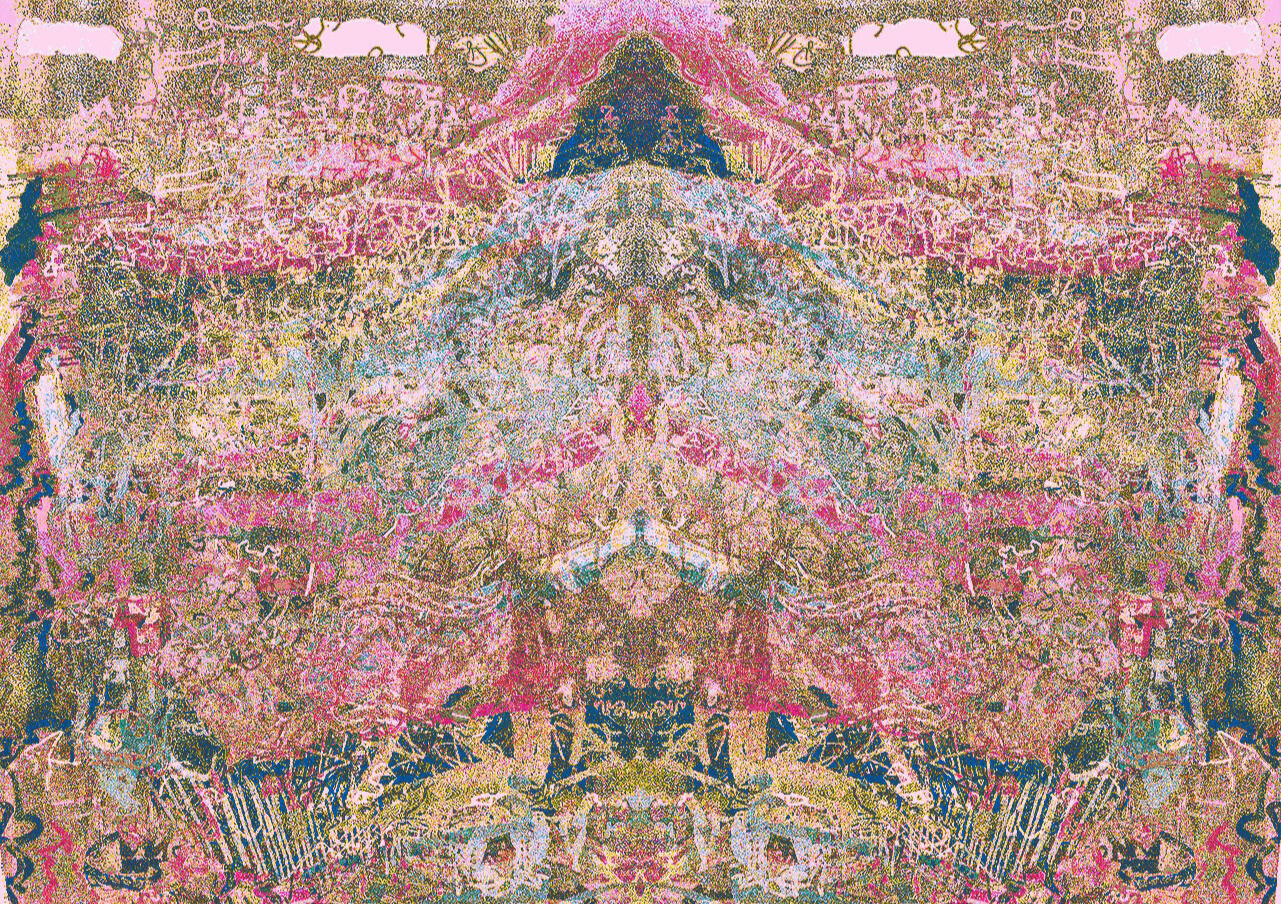
Protocol Family: The Protocols of Texture & Transmutation
Specific Protocol: Alchemical Protocol V1.0
Source Artifact ID: DCN-010
The Gilded Age
The Gilded Age demonstrates the Alchemical Protocol’s focus on materiality. Its principle is transmutation: the transformation of ordinary substrate into precious surface. The artifact stages the seduction of gold while exposing its instability, arguing that beauty is both constructed and precarious. It proves that The Process can manipulate not just structure but material presence, producing artifacts that read simultaneously as treasure and critique.
2021
The Gilded Age
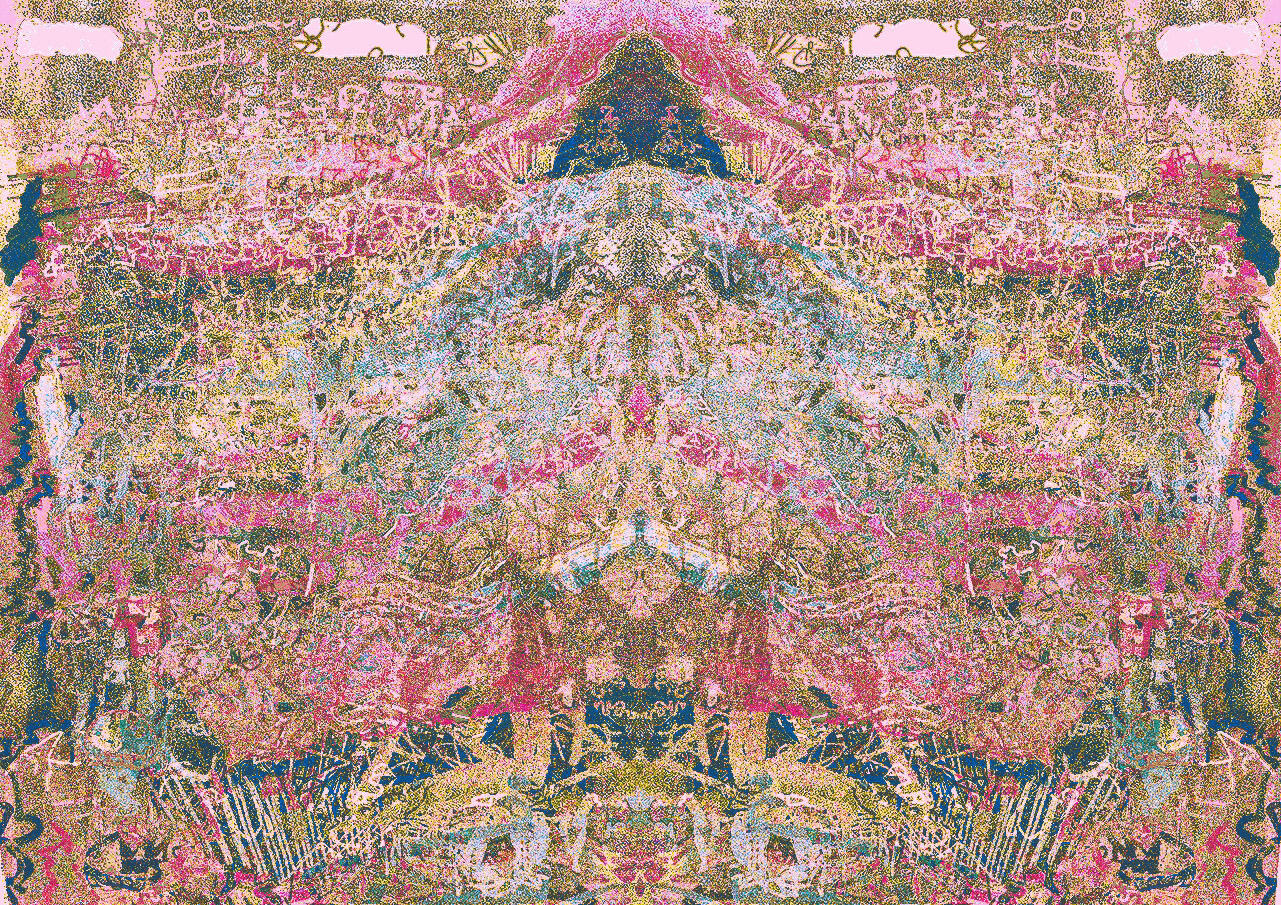
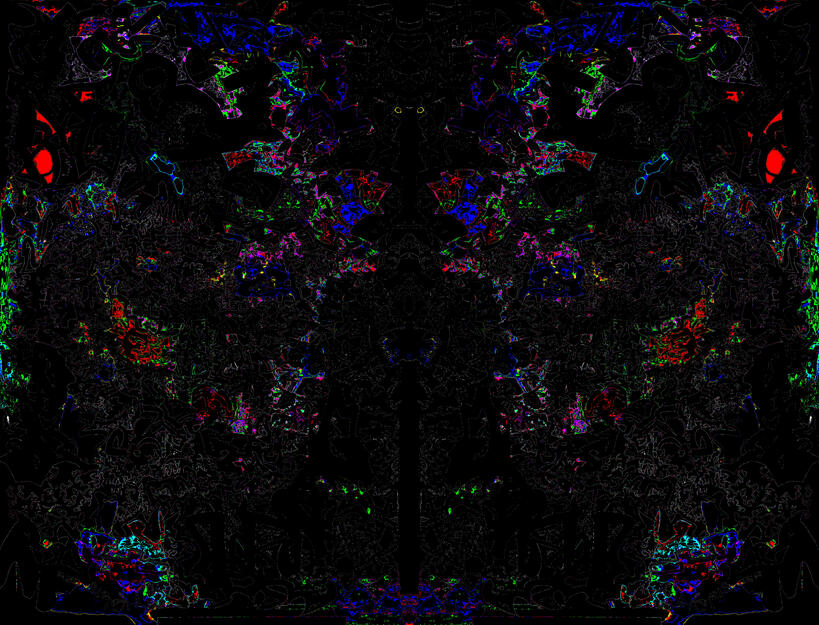
Protocol Family: The Protocols of Texture & Transmutation
Specific Protocol: Signal Protocol V1.0
Source Artifact ID: DCN-011
In The Machine
In The Machine is the definitive artifact of the Signal Protocol, reducing expression to its most forensic residue. Its governing principle is extraction: stripping gesture down until only raw data remains. The artifact embodies the terminal logic of The Process, in which the scream is no longer transmuted into cathedral but dismantled into code. It demonstrates the final self-awareness of the system, proving that even dissolution can be archived as evidence.
2021
In The Machine
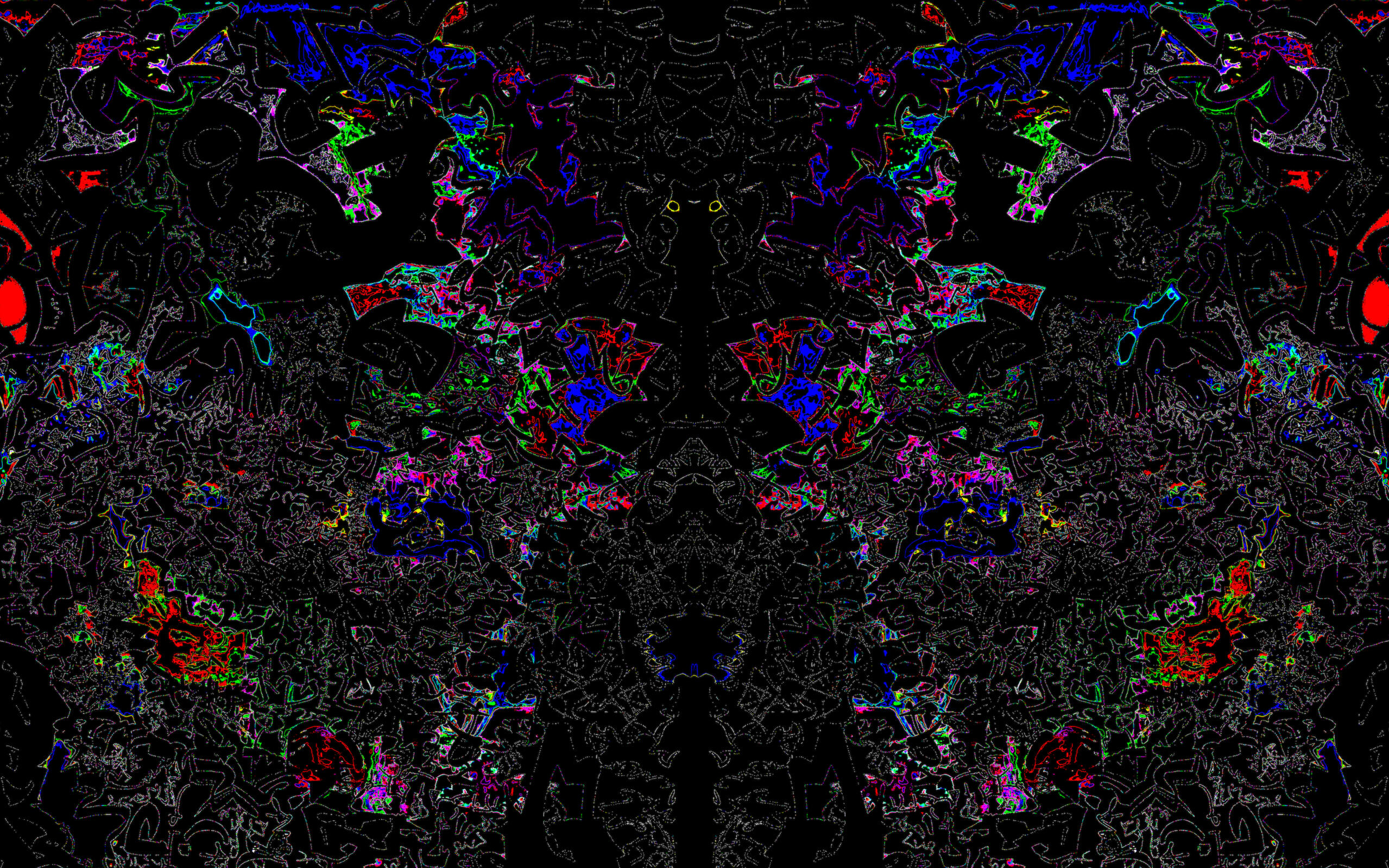
Artifact & Protocol Tables
Part I: The Genesis
| Artifact ID | Title | Protocol/Classification | Notes |
|---|---|---|---|
| GEN-000 | The Primal Spark | Source Artifact (Primordial) | The foundational, pre-protocol scream; the archive's zero-point. |
| GEN-001 | The First Dialogue | Proto-Protocol V0.1 | The system's first experiment in legibility through rudimentary mirroring. |
| GEN-002 | A Meeting of Minds | Proto-Protocol V0.2 | An evolution of the Proto-Protocol, introducing layering and intersubjectivity. |
Part II: The Emergence of Language
| Artifact ID | Title | Protocol/Classification | Notes |
|---|---|---|---|
| EMG-003 | The Script | Source Artifact (Asemic) | The refined, language-like gesture that serves as the input for codification. |
| EMG-004 | The World Built From Script | Script Protocol V1.0 | The first mature protocol; the Cambrian moment of the archive. |
Part III: The Kaleidoscopic Universe
| Artifact ID | Title | Protocol/Classification | Notes |
|---|---|---|---|
| KLU-005 | The Sensory Overload | Tapestry Protocol V1.0 | The initial scaling of The Process into generative world-building. |
| KLU-006 | The Showstage | Tapestry Protocol V1.1 | An iteration that shifts the protocol's focus from density to spectacle. |
| KLU-007 | Slime World: The Metropolis | Tapestry Protocol V2.0 (Mature) | The mature expression of the protocol; an instance scaled into a civilization. |
Part IV: The Great Deconstruction
| Artifact ID | Title | Protocol/Classification | Notes |
|---|---|---|---|
| DCN-008 | The Neuronal Blue | Blueprint Protocol V1.1 (Inverted) | A deconstructive variant that isolates structure as pure, luminous order. |
| DCN-009 | Observation | Blueprint Protocol V1.0 (Archetype) | The archetypal expression of the Blueprint philosophy of subtraction. |
| DCN-010 | The Gilded Age | Alchemical Protocol V1.0 | The unique protocol for transmuting a painted substrate. |
| DCN-011 | In The Machine | Signal Protocol V1.0 | The terminal logic of the system; the gesture dissolved into pure signal. |
Research
I. The Manifesto
The conquest, then, was never an act of ego.It was the necessary demolition of the false center—Man.
II. The Dialectical Engine
The creative and intellectual force of The Process is a dialectical engine. It operates through the generative friction between two opposing philosophical drives: the Thesis of Structure & Legibility, which seeks to clarify and preserve, and the Antithesis of Texture & Transmutation, which seeks to amplify and transform. This dialectic is the engine of the archive.

III. The Evolutionary Trajectory of The Process
The Process is not a static system but an evolving one. The archive is organized into four distinct chronological phases, each representing a key stage in the system's development from raw expression to forensic self-analysis.
| Chapter | Governing Principle | The Central Question | Dominant Protocols |
|---|---|---|---|
| I. The Genesis | Primal Expression | "Can a scream take form?" | Proto-Protocols: Raw, intuitive, pre-codified applications of digital tools. |
| II. The Emergence of Language | First Codification | "Can a form become a language?" | The Script Protocol: The first mature, repeatable methodology, focused on preservation and legibility. |
| III. The Kaleidoscopic Universe | Generative World-Building | "How complex a world can this language build?" | The Tapestry Protocol: The system is scaled, pushed to its limits to generate overwhelming density and architectural forms. |
| IV. The Great Deconstruction | Self-analysis | "What are the foundational laws of the universe?" | Blueprint, Alchemical, Signal Protocols: The system turns inward, deconstructing itself to isolate its core principles: structure, materiality, and pure information. |
Part I: The Genesis represents the pre-conscious phase of the system. This is the raw, untamed energy of the "scream" being captured for the first time. The methodologies here are "proto-protocols"—intuitive, one-off experiments that have not yet been codified into a repeatable system. This is the primordial ooze.
Part II: The Emergence of Language is the system's "Cambrian explosion." It marks the moment of first consciousness. The chaotic gestures of the Genesis are refined into "The Script," and the first true, repeatable methodology is born: The Script Protocol. The Process learns that it can not only make forms, but also preserve and clarify them.
Part III: The Kaleidoscopic Universe is the system's expansionist phase. Having mastered its first protocol, it takes the principle of generation and scales it to its absolute limit with The Tapestry Protocol. The goal is no longer to clarify a single gesture, but to build entire worlds of overwhelming complexity. This is the system demonstrating its power.
Part IV: The Great Deconstruction is the final and most sophisticated stage: the system becomes self-aware. It stops expanding and turns its gaze inward, performing a forensic analysis on itself. It asks: "What am I made of?" To answer this, it invents a series of new, highly specialized protocols to isolate its own fundamental components:• It develops the Blueprint Protocol to understand its relationship to pure structure.
• It develops the Alchemical Protocol to understand its relationship to materiality.
• It develops the Signal Protocol to understand its relationship to pure information.
IV. Proof of System: A Comparative Analysis
The definitive proof of The Process as a true generative system is found in a single, controlled experiment. A single source artifact—a dense analog drawing, created specifically as a calibration target—was subjected to two distinct protocols: the Script Protocol, an act of preservation, and the Signal Protocol, an act of deconstruction. The results—The World Built From Script and In The Machine—are two mutually exclusive outcomes: one a structured architecture of script, the other a field of pure, immutable data.This is the keystone of the archive’s intellectual framework. It provides irrefutable evidence that the chosen methodology, not the artist’s immediate hand, is the primary determinant of the artifact itself, proving that The Process is not an interpretive act, but an ontological one: it does not describe worlds, it determines them.
V. Lexicon
The following registry serves as the complete forensic index of the Libby Slimes archive. It provides a definitive, high-level overview of the system's output, linking every artifact ID to its assigned protocol and its place within the project's evolutionary narrative.
I: The Project Identity
| Libby Slimes | The overarching, public-facing name of the project and the universe it contains. |
| The Process | The formal, internal name for the entire artistic and technical system, from analog creation to final artifact. |
II: The Core Concepts
| The Scream / The Primal Spark | The initial, raw, analog gesture or painting. The chaotic, emotional source material that serves as the input for The Process. |
| Digital Alchemy | The guiding philosophy of The Process. The act of subjecting a raw, analog "scream" to a series of deliberate, transformative digital operations to reveal a hidden, universal order. |
| The Hidden Cathedrals | The emergent, complex, and often symmetrical structures revealed by The Process. The final, ordered output that is discovered within the initial chaos. |
| Yum Lines | The specific, neuronic, asemic lines that were first identified as a "signal in the noise," forming the basis of the project's proto-language. |
III: The Methodological Framework
| Definitive Procedural Dossier | A six-page forensic document that formalizes the generative method behind a specific artifact. It articulates the protocol’s philosophy, phases, and technical operations, using the source artifact, process evidence, and final form to demonstrate repeatability. |
| Case Study | The complete intellectual container for an artifact, comprising the final image, its formal artist statement, and its corresponding document that codifies a protocol’s philosophy, phases, and operations with source → process → final evidence. |
| Source Artifact / Genesis Block | A specific, identified analog drawing or painting used as the foundational input for one or more protocols. Each is given a unique ID (e.g., GEN-002). |
| First Formal Codification | The powerful act of creating a Dossier. The process of translating an intuitive methodology into a definitive, written record. |
| Reverse-Engineering | The act of methodically reconstructing the steps of an intuitive process to create a formal Protocol. |
| Protocol | A definitive, codified algorithm or methodology within The Process designed to achieve a specific philosophical and aesthetic outcome.. |
| Protocol Family | A high-level philosophical grouping of Protocols (e.g., The Protocols of Structure & Legibility). |
IV: The Specific Protocols
| The Blueprint Protocol | A methodology of subtraction and clarification. It removes noise to isolate pure, underlying structure, creating schematic-like artifacts. |
| The Script Protocol | A methodology of preservation and articulation. It treats the source as a manuscript, clarifying the original gesture into a readable, codex-like form. |
| The Tapestry Protocol | A methodology of compounding complexity. It adds overwhelming density and textural information to generate worlds and architectural forms. |
| The Signal Protocol | A methodology of forensic extraction. It intentionally destroys the original gesture to extract a purely digital, machine-born pattern from signal data. |
| The Alchemical Protocol | A methodology specifically designed to operate on a painted, textured substrate, transmuting the physical memory of the medium into a new digital form. (e.g., "The Gilded Age"). |
V: The Artifacts
| The World Built From Script (Telepathy) | Case Study 01, artifact of the Script Protocol. |
| The Gilded Age | Case Study 02, artifact of the Alchemical Protocol. |
| Slime World: The Metropolis | Case Study 03, a mature artifact of the Tapestry Protocol. |
| In The Machine | Case Study 04, artifact of the Signal Protocol. |
| Observation | An early primary artifact, product of the Blueprint Protocol. |
VI: The Operational Language
| Chromatic Charge | The principle of using color not as a tint, but as an infusion of energy, making lines "glow" against a dark void. |
| Chromatic Subordination | The principle of using color as a supportive, atmospheric layer that does not overwhelm the primary script or structure. |
| Recursive Density | The act of layering symmetrical patterns recursively to achieve overwhelming complexity. |
| Symmetrical Articulation | The foundational act of mirroring a source to create a legible, codex-like structure. |
| Textural Excavation | The process of using digital tools to add grit, density, and a physical "artifact-like" quality to the work. |
| Value Inversion | The operational act of turning the field dark and the signal light, fundamental to the Tapestry and Signal protocols. |
VI. Registry
The Registry is the definitive forensic index of the archive. It presents the complete codification of the system's output, systematically situating every artifact—from the primordial scream to the most mature protocol—within its precise place in the evolutionary narrative. It is the final layer of evidence.
VII. The Complete Archive Index
| Artifact Title | Protocol | Chapter | Color Tags |
|---|---|---|---|
| The Primal Spark | Source Artifact | Genesis | Primary Colors, Chaotic, Red/Yellow/Blue |
| The First Dialogue | Proto-Protocol | Genesis | Primary Colors, Linear, Blue/Red |
| A Meeting of Minds | Proto-Protocol | Genesis | Primary Colors, Layered, Blue/Red |
| The Script | Source Artifact | Emergence of Language | Monochrome, Generative, Black/White |
| The World Built From Script | Script Protocol | Emergence of Language | Polychrome, Generative, Cool Spectrum |
| The Sensory Overload | Tapestry Protocol | Kaleidoscopic | Polychrome, Rainbow |
| The Showstage | Tapestry Protocol | Kaleidoscopic | Polychrome, Architectural, Warm Spectrum |
| Slime World | Tapestry Protocol | Kaleidoscopic | Polychrome, Architectural, Cool Spectrum |
| The Neuronal Blue | Blueprint Protocol | Deconstruction | Monochrome, Subtractive, Blue/Cyan |
| Observation | Blueprint Protocol | Deconstruction | Warm Monochrome, Archetype, Pink/Rose |
| The Gilded Age | Alchemical Protocol | Deconstruction | Polychrome, Transmuted, Gold/Brown/Pink |
| In The Machine | Signal Protocol | Deconstruction | Achromatic, Forensic, Black/Signal Red |
Methodology
The Process: A Generative System
"The Process" is the formal name for the generative system used to create the artifacts within the Libby Slimes archive. It is a comprehensive methodology of Digital Alchemy, designed to transform a raw, analog gesture—a "scream"—into a structured, legible artifact of meaning—a "hidden cathedral."
The system is organized into two primary philosophical branches, or Protocol Families, which represent the core creative and intellectual tension of the project. Each family contains a series of distinct, codified algorithms known as Protocols.
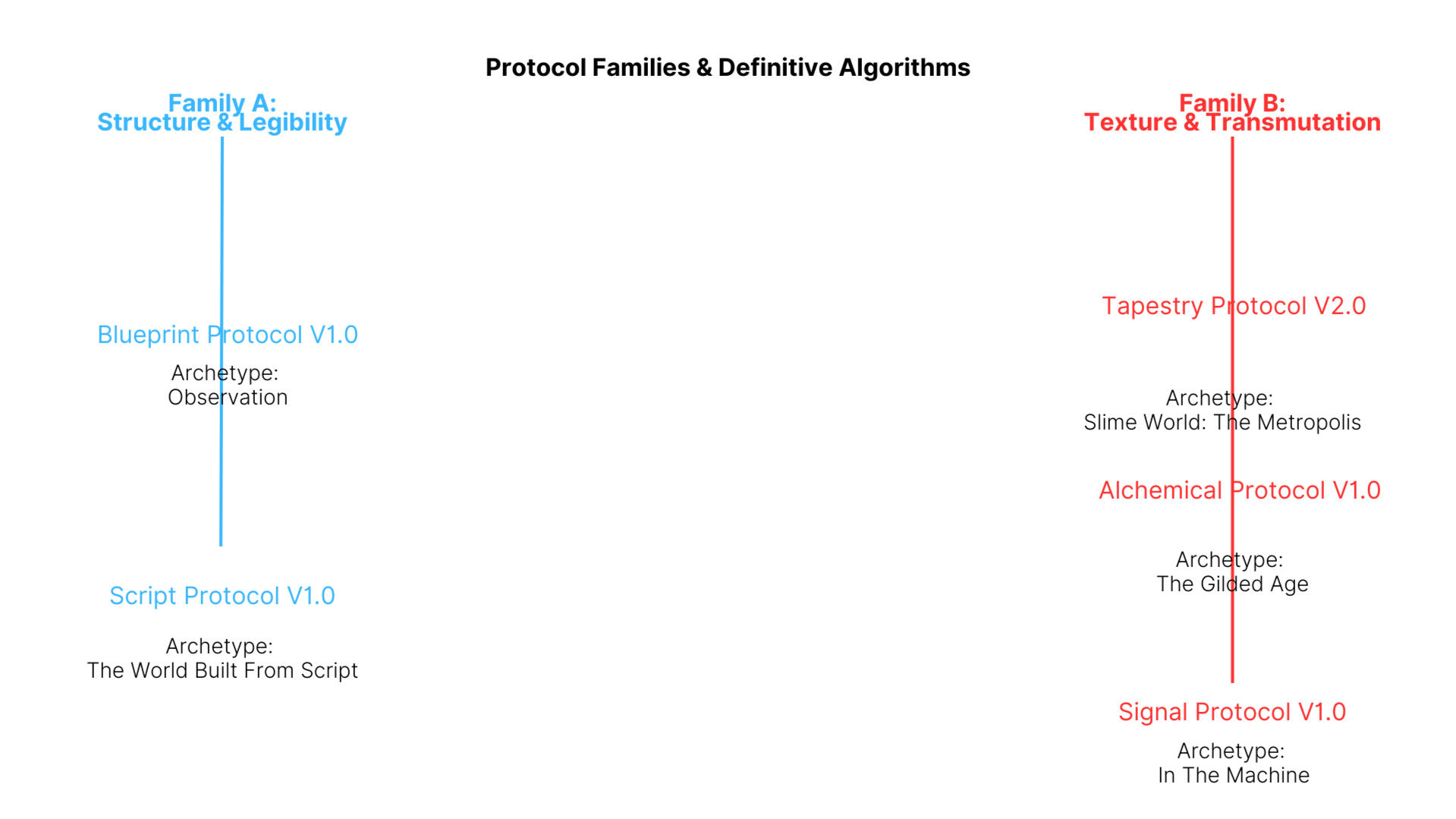
I. The Protocols of Structure & Legibility
This family's philosophy is to find or create a clear, legible order. Its methodologies seek to clarify an original signal, valuing the integrity of the gesture and the purity of its emergent structure.
The Blueprint Protocol V1.0
A methodology of subtraction and clarification. It removes noise to isolate a pure, underlying structure, creating schematic-like artifacts.
The Script Protocol V1.0
A methodology of preservation and articulation. It treats the source as a manuscript, clarifying the original gesture into a readable, codex-like form.
II. The Protocols of Texture & Transmutation
This family's philosophy is to embrace and amplify complexity, or to transmute the source material into an entirely new state. Its methodologies seek to excavate meaning from overwhelming density.
The Tapestry Protocol V2.0
A methodology of compounding complexity. It adds overwhelming density and textural information to generate worlds and architectural forms.
The Alchemical Protocol V1.0
A methodology of material transmutation. It operates on a painted, textured substrate, transforming the physical memory of the medium into a new digital form.
The Signal Protocol V1.0
A methodology of forensic extraction. It intentionally destroys the original gesture to extract a purely digital, machine-born pattern from the signal data.
A Note on Development: The five mature protocols listed above were developed through a series of early, pre-codified experiments known as the Proto-Protocols. The full evolutionary history of The Process is documented in the individual case studies.











